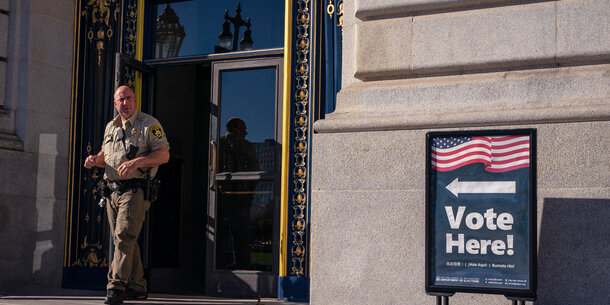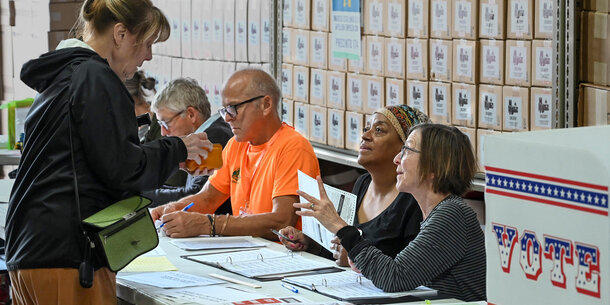With at least half the votes in the November election expected to be cast by mail, Americans must prepare to wait for results well past Election Day. In recent years, a growing number of states have allowed all voters to vote by mail, and others have expanded such programs to help prevent the spread of Covid-19. It may take days, if not weeks, to count an expected record number of mail-in votes — something many states have little experience with. Election officials, political candidates, members of the media, and the general public must wait for every vote to be counted to ensure the fairness and accuracy of the election. Instead of expecting results on Election Day, it may be best to prepare for an election week or even an election month.
How are votes counted and reported on election night?
The United States has a decentralized election system, so rules vary between states. Once polls close, poll workers complete a variety of tasks (which may vary by state and jurisdiction), — such as reconciling the total number of paper ballots and comparing the number of total number of voters checked in to the total number of votes cast — before reporting out unofficial results. Poll workers may post a paper copy of the unofficial results at the location, and then unofficial results are transferred to a central location — by phone or electronically, or by transporting a memory device by car or even helicopter. The unofficial results from individual polling sites are published online, often on local and state election official websites.
On election night, the Associated Press has more than 4,000 freelance reporters who report to individual polling locations and/or county election centers around the country, which will be virtual this year. These reporters call in vote totals to more than 800 AP vote entry clerks, who inquire about any voting irregularities and question any results that look suspect. Quality control software monitors any inconsistencies or results that are statistically unlikely, and researchers and analysts verify the data. Before calling any race, the AP relies on the tallies, on-the-ground reports, information about voter demographics, absentee and mail-in ballots, and each jurisdiction’s voting history.
The AP sends the county voting information to the news networks, which also receive local, precinct-level data from election officials. The AP and the five major news networks — ABC, CBS, CNN, Fox, and NBC — are members of the National Election Pool, a consortium that was formed in 2003 to provide vote counts, analysis, and projections. The National Election Pool partners with Edison Research, a company that conducts exit polling and shares information such as voter demographics and reasons for supporting a particular candidate. Each network also uses its own analysts, pollsters, and statistical models before calling any race.
How could this year’s election differ from past ones?
Experts are predicting that mail ballots could make up at least half of all votes cast election due to the Covid-19 pandemic. Multiple states have expanded access to mail-in voting to address fears about in-person voting during a pandemic. At least three-quarters of Americans will be eligible for a mail ballot this year — the most in history. About 80 million votes are expected to be cast by mail, which is double the number in 2016.
Mail-in ballots take longer to process and count than in-person ballots. Election officials must review the information on the return envelope and confirm voter eligibility, sort and open the envelopes, and then tabulate the paper ballots. Some states only count ballots received by the close of the polls on Election Day, and some states count ballots that are received in the days after the election so long as they were postmarked on or before Election Day. In general, absentee ballots cast by U.S. citizens living or traveling abroad and military members overseas must comply with the same return rules, but some states may provide additional return time to these voters under certain circumstances.
Provisional ballots — which may be used if a potential voter’s eligibility is questioned on Election Day and in some states must be given to voters who request mail ballots but decide to vote in person instead — require additional time as election officials must determine their eligibility. Social distancing requirements for workplaces may slow the process of verifying these ballots.
Can mail ballots and early votes be counted before Election Day?
All election officials are prohibited from releasing election results until after the polls close. However, some election officials in some states are authorized to process and/or tabulate certain results, such as absentee ballots or early votes, prior to Election Day. In practice, this means that unofficial early voting results are published almost immediately after the close of the polls in some states, or that partial absentee voting results are released shortly after the polls close.
There may also be uneven reporting lags between the close of the polls and the reporting of unofficial results from individual polling locations because of the size of the polling location or whether poll workers need extra time to complete reconciliations or continue allowing people who were in line when the polls closed to vote. This year, some election officials have asked for changes in laws that would allow them to verify and count ballots ahead of Election Day to prevent delays.
How should vote totals that are available on election night be treated?
On election night, journalists, candidates, and their parties should account for the anticipated spike in mail-in ballots by avoiding universal references to the “percentage of districts reporting” results. While some states may have information about the total number of mail ballots cast, others will not. For the latter group, it’s important not to report results that could be misleading because they don’t account for thousands or even millions of votes that have yet to be counted because they are arriving by mail.
Voters must be prepared to wait for results well past Election Day and understand that a delay simply means that ballots are still being counted — which is critical for fairness and accuracy. President Trump has repeatedly attacked mail-in voting and has been trying to delegitimize the election, and it is critical to protect the credibility of our democratic process by ensuring each vote is counted.
There could be a political divide between votes cast in person and those sent by mail. Some data shows that Democrats are more likely to vote by mail and to receive provisional ballots, while Republicans are more likely to vote in person. Even if one candidate holds a comfortable lead on Election Day, the high number of mail ballots tallied in the following days or weeks could change the outcome. Media professionals, political candidates, campaign teams, and political parties must not call any races prematurely to avoid spreading false information and compromising election integrity. A group of experts has warned that delays in tallies are expected this year and recommended outreach campaigns to prepare the public for this likely scenario.
What should voters do?
In states that allow in-person early voting, voters should consider casting a ballot before Election Day — in some places this can be days or even weeks ahead of November 3. If voting by mail, voters should request their mail-in or absentee ballots as soon as possible and send them well ahead of Election Day to ensure they arrive on time. This can be done by mail or by dropping them off in a designated location, which can include mail ballot drop boxes.
For information on the election and vote counts, voters should turn to election officials and credible news sources.
While Americans are accustomed to speedy unofficial election results on Election Night, experts are predicting a close election in many states. As always with close elections, every vote counts. And as always, unofficial results on Election Night will be incomplete for reasons discussed above, such as spikes in mail ballots, restrictions on when mail ballot processing and tabulating may begin, provisional ballots cast that need to be adjudicated, and mail ballots that must be counted in states that allow them to be mailed up to Election Day.
Officials across the country will work to provide complete unofficial results as soon as possible, but that may take days or weeks in some states. However, election officials do expect to complete the canvass — which generally includes checking individual polling location reconciliation reports — and the formal confirmation of election results in a timely manner as they always have.
The best way to ensure election integrity is to count every eligible American citizen’s vote. And this year, as with previous elections, the process will continue in the days following the election, and unofficial results will change as provisional ballots are adjudicated and as officials have time to process and tabulate absentee ballots. It’s more important for election officials to get it right than to get it done quickly.


